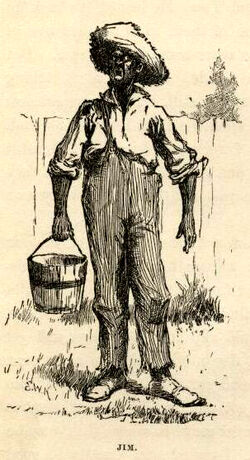| Jim | |
|---|---|
 | |
|
Real Name |
Jim |
|
First Appearance |
The Adventures of Tom Sawyer (1876) |
|
Original Publisher |
American Publishing Company |
|
Created by |
Samuel Clemens (as "Mark Twain") |
Origin[]
Jim is Aunt Polly's slave boy. He seems to be about Tom's age, but his life is totally different. As a slave, he isn't involved in any of the adventures throughout the book, The Adventures of Tom Sawyer. The only time it ever mentions him is near the beginning of the book when Tom tries to convince him to do the whitewashing for him. Jim refuses to do the work, because the "Ole Misses" told him not to fool around and go straight to work. Tom is about to succeed in making Jim do his work, when he shows Jim his sore toe, but Aunt Polly spots him and chases him with a shoe.
The character is introduced again at the beginning of Chapter Two of Adventures of Huckleberry Finn, now a slave of Miss Watson, the Widow Douglas' sister, and seen at midnight by the two boys, Huck and Tom, standing silhouetted in the doorway of the outdoor detached kitchen. He hears them approach and inquires into the darkness; he states that he will wait to hear the sound repeated, and he sits at the doorway until he dozes, relieving the hidden narrator's tension indicated by an entire paragraph on an itch unscratched because of fear, of which Jim is unaware. He awakens from dreams of witches, and from a nickel left by the boys becomes a storyteller of regional fame, able to command pay for his tales, and in the concluding phrase, all but unfit to be a servant.
His character and perceptions dominate the novel and include spirituality, parental tenderness, and nonviolence: he leaves unmolested two rogues - Jim's term is "rascals" - who have taken over the raft despite their vulnerability as they sleep drunk.
When this character's vision stops carrying the novel - the rogues sell Jim as an escaped slave - the character Tom Sawyer's scenarios take over. Jim's dangerous situation is parodied in a series of clownish pranks that reveal his long-suffering and noble spirit.
Later, the Widow Douglas attempts to "sivilize" the newly wealthy Huck. Huck's father takes him from her, but Huck manages to fake his own death and escape to Jackson's Island, where he coincidentally meets up with Jim.
Jim is running away because he overheard Miss Watson planning to "sell him South" for eight hundred dollars. Jim wants to escape to Ohio, where he can find work to eventually buy his family's freedom. Huck and Jim take a raft down the Mississippi River in hopes of finding freedom from slavery for Jim and freedom from Pap for Huck. Their adventures together, along with Huck's solo adventures, comprise the core of the book.
In the end, however, Jim gains his freedom through Miss Watson's death, as she freed him in her will.
Public Domain Appearances[]
Book:
- Adventures of Tom Sawyer (1876)
- Adventures of Huckleberry Finn (1884)
Film:
- Tom Sawyer (1917)
- Huck and Tom (1918)
- Huckleberry Finn (1920)
Notes[]
- Adventures of Huckleberry Finn has been one of the most-challenged books in the USA, both for exposing the ignorance and racism of the South and, paradoxically, for being racist itself. Craig Lancto, then education editor of World & I magazine, wrote: "Nigger is an ugly word that ignites strong feelings and diminishes both speaker and hearer. Of course, neither Huck nor Tom meant it in a derogatory way. It was what they heard adults of their day say. Their behavior did not reflect racism, but those who would ban the book because of it rob students of the opportunity to discover that Twain was not a racist. Instead, they exacerbate racial tensions by finding racism where it does not exist."
- Others have suggested the word be removed altogether from future prints.
- Also, the words "nigger" and "Jim" appear side-by-side only once in Adventures of Huckleberry Finn, in Chapter XXXI, in a letter Huck writes to Miss Watson, but they are NOT used as a name. It wasn't until after "nigger Jim" appeared in Albert Bigelow Paine's 1912 biography of Samuel Clemens, it continued to be used by twentieth century critics.